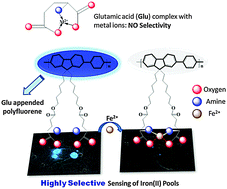Orientation effect induced selective chelation of Fe2+ to a glutamic acid appended conjugated polymer for sensing and live cell imaging†
Abstract
Intracellular detection and imaging of labile iron(II) pools is very important in tracking physiological processes that demand new and rapid sensing probes. In this report, we present a water soluble polymer based probe for the fluorescence sensing and live cell imaging of labile Fe2+ ions with high selectivity for the first time. The polymer probe was based on conjugated polyfluorene which was appended with amino acid (L-glutamic acid). The biocompatibility of the polymer was confirmed from an MTT assay which demonstrated >90% cell viability even at 300 μg ml−1 loading of polymers. Simple glutamic acid did not show selectivity towards any of the divalent ions. However, glutamic acid appended polyfluorene exhibited selective chelation to Fe2+ ions resulting in immediate sensing activity for Fe2+ ions in water and living cells with fluorescence turn-off response. The limit of detection of the PF-Ph-GA polymer probe was 46 (±2) nM which indicated high sensitivity for Fe2+ over other ions reported in the literature. The polymer also exhibited improved sensing activity in the range of intracellular pH (5–9) which is advantageous in differentiating endogenous changes. The probe was successfully applied for the fluorescence imaging of intracellular and supplemented labile iron(II) pools in living HeLa cells.


 Please wait while we load your content...
Please wait while we load your content...